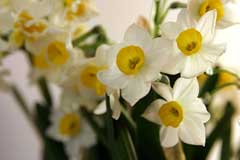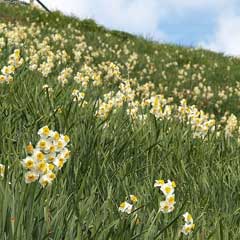 |
|
http://www.flickr.com/photos/10528089@N00 |
 |
| http://commons.wikimedia.org/wiki/User:OpenCage |
Translate this page:
Summary
Physical Characteristics

 Narcissus tazetta is a BULB growing to 0.5 m (1ft 8in) by 0.1 m (0ft 4in).
Narcissus tazetta is a BULB growing to 0.5 m (1ft 8in) by 0.1 m (0ft 4in).
See above for USDA hardiness. It is hardy to UK zone 8 and is not frost tender. It is in flower from January to February. The species is hermaphrodite (has both male and female organs) and is pollinated by Bees.
Suitable for: light (sandy), medium (loamy) and heavy (clay) soils and can grow in heavy clay soil. Suitable pH: mildly acid, neutral and basic (mildly alkaline) soils and can grow in very alkaline soils.
It cannot grow in the shade. It prefers moist soil.
UK Hardiness Map
US Hardiness Map
Synonyms
Plant Habitats
Cultivated Beds;
Edible Uses
References More on Edible Uses
Medicinal Uses
Plants For A Future can not take any responsibility for any adverse effects from the use of plants. Always seek advice from a professional before using a plant medicinally.
Analgesic Antiphlogistic Cancer Demulcent Emetic Poultice
Demulcent[174, 178]. Used in the treatment of boils and mastitis[174]. The root is emetic[240]. It is used to relieve headaches[240]. The chopped root is applied externally as an antiphlogistic and analgesic poultice to abscesses, boils and other skin complaints[218]. The plant has a folklore of effectiveness against certain forms of cancer. This might be due to benzaldehyde changing to laetrile-like compounds or to lycorine changing to lycobetaine-like compounds in the body[218].
References More on Medicinal Uses
The Bookshop: Edible Plant Books
Our Latest books on Perennial Plants For Food Forests and Permaculture Gardens in paperback or digital formats.

Edible Tropical Plants
Food Forest Plants for Hotter Conditions: 250+ Plants For Tropical Food Forests & Permaculture Gardens.
More

Edible Temperate Plants
Plants for Your Food Forest: 500 Plants for Temperate Food Forests & Permaculture Gardens.
More

More Books
PFAF have eight books available in paperback and digital formats. Browse the shop for more information.
Shop Now
Other Uses
References More on Other Uses
Cultivation details
Prefers a deep rather stiff soil but succeeds in most soils and situations[1]. Grows well in heavy clay soils. Prefers an alkaline soil with a pH between 7 and 8[200]. Best grown in a warm sunny corner with shelter from cold winds[245]. The dormant bulbs will withstand soil temperatures down to at least -5°c[214]. A polymorphic species[200]. Cultivated for its essential oil[171]. The flowers are very powerfully scented[245]. The sub-species N. tazetta chinensis. Roemer. is used in Japanese medicine[174].
References Carbon Farming Information and Carbon Sequestration Information
Temperature Converter
Type a value in the Celsius field to convert the value to Fahrenheit:
Fahrenheit:
The PFAF Bookshop
Plants For A Future have a number of books available in paperback and digital form. Book titles include Edible Plants, Edible Perennials, Edible Trees,Edible Shrubs, Woodland Gardening, and Temperate Food Forest Plants. Our new book is Food Forest Plants For Hotter Conditions (Tropical and Sub-Tropical).
Shop Now
Plant Propagation
Seed - best sown as soon as it is ripe in a cold frame. A short stratification will improve the germination of stored seed. Sow the seed thinly so that the seedlings can be left undisturbed in the pot for their first two years of growth. Give them an occasional liquid feed in the growing season to ensure they do not become nutrient deficient. When the plants become dormant in the summer, pot up the small bulbs placing 2 - 3 bulbs in each pot. Grow them on for another one or two years in the greenhouse before planting them out when they are dormant in late summer. Division of bulbs after the leaves die down in early summer[1]. Larger bulbs can be replanted immediately into their permanent positions, or can be stored in a cool place and then be planted out in the autumn. It is best to pot up the smaller bulbs and grow them on for a year before planting them out when dormant in the autumn.
Other Names
If available other names are mentioned here
Native Range
TEMPERATE ASIA: Cyprus, Iran (natzd.?), Iraq, Israel, Jordan, Lebanon, Syria, Turkey, Russian Federation-Ciscaucasia (Ciscaucasia), Russian Federation-Western Siberia (Western Siberia), China (Fujian Sheng, Zhejiang Sheng) EUROPE: Russian Federation (European part), Former Yugoslavia, Albania, Greece (incl. Crete), Italy (incl. Sardinia, Sicily), Spain (incl. Baleares), France (incl. Corsica), Portugal AFRICA: Algeria, Egypt, Libya, Morocco
Weed Potential
Right plant wrong place. We are currently updating this section.
Please note that a plant may be invasive in one area but may not in your area so it's worth checking.
Conservation Status
IUCN Red List of Threatened Plants Status :

Growth: S = slow M = medium F = fast. Soil: L = light (sandy) M = medium H = heavy (clay). pH: A = acid N = neutral B = basic (alkaline). Shade: F = full shade S = semi-shade N = no shade. Moisture: D = dry M = Moist We = wet Wa = water.
Now available:
Food Forest Plants for Mediterranean Conditions
350+ Perennial Plants For Mediterranean and Drier Food Forests and Permaculture Gardens.
[Paperback and eBook]
This is the third in Plants For A Future's series of plant guides for food forests tailored to
specific climate zones. Following volumes on temperate and tropical ecosystems, this book focuses
on species suited to Mediterranean conditions—regions with hot, dry summers and cool, wet winters,
often facing the added challenge of climate change.
Read More
Expert comment
Author
L.
Botanical References
89200
Links / References
For a list of references used on this page please go here
Readers comment
© 2010, Plants For A Future. Plants For A Future is a charitable company limited by guarantee, registered in England and Wales. Charity No. 1057719, Company No. 3204567.